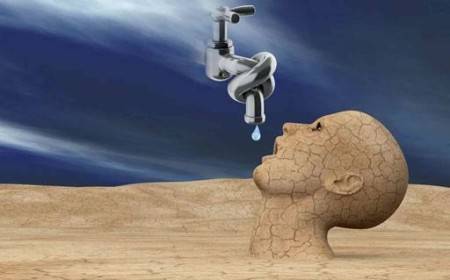The revenge of the climate on humans, who are primarily responsible for the destruction of the Earth, should not be underestimated. Let's say the battle is at its peak as drought spreads in some areas while storms, heavy rainfall, and floods (due to rising temperatures causing high humidity in the atmosphere) engulf the remaining land struggling these days. While it is possible to adapt to climate extremes to some extent, water scarcity is a red line that is difficult to cross due to its implications on health and human survival. Food supplies remain dependent on the absence of climate extremes, sound population growth, and the availability of freshwater. To sustain this trio, the United Nations launched its call this year under the slogan: "Water… at the Heart of the Climate Crisis."
**Climate Change and Water**
The United Nations emphasizes the close and complex link between water and climate change, listing patterns: "Climate change affects the world's water in complex ways. From unpredictable rainfall patterns to shrinking ice sheets, rising sea levels, floods, and droughts – most of these are water-related climate changes." UNICEF warns of the threat posed by climate change in exacerbating water scarcity, floods, drought, rising temperatures, and heavy rainfall, negatively impacting the entire water cycle.
**Water Scarcity**
The 2022 Sustainable Development Goals report published by the United Nations points to the fact that around two billion people worldwide struggle to access safe drinking water. According to the Intergovernmental Panel on Climate Change (IPCC), nearly half of the world’s population suffers from severe water scarcity at least part of the year. These figures are expected to worsen due to climate change and population growth, as explained by the World Meteorological Organization: "Only 0.5 percent of the Earth's water is suitable for use as available freshwater - and climate change severely affects this supply." Over the past two decades, groundwater stocks—including soil moisture, snow, and ice—have declined by an average of 1 cm per year, leading to significant implications for water security. The IPCC notes that water stored in glaciers and snow cover is expected to decline further over the century, reducing water availability during warmer and drier periods in areas served by melting snow from major mountain ranges where more than one-sixth of the world’s population lives. Rising sea levels are also expected to increase salinity of groundwater, reducing the availability of freshwater for humans and ecosystems in coastal areas.
It adds, "Limiting global warming to 1.5 degrees Celsius compared to 2 degrees Celsius could nearly halve the proportion of the world’s population expected to face water scarcity, although there is significant variation between regions." Water quality is also affected by climate change, with rising water temperatures and the frequency of floods and droughts expected to exacerbate many forms of water pollution—from sediments to pathogens and pesticides.
**Food Security**
The Food and Agriculture Organization (FAO) stresses the importance of food security, noting that "climate change, population growth, and increasing water scarcity are factors that could put pressure on food supplies as most freshwater used, about 70 percent on average, is used for agriculture (producing daily food for one person requires between 2,000 and 5,000 liters of water)."
**Water-Related Risks**
Alongside warnings from the IPCC about the relationship between rising global temperatures and increased humidity that the atmosphere can hold, leading to more storms and heavy rainfall, the World Bank warns of more severe droughts with increased evaporation from the land and changing global weather patterns. It adds, "Rising global temperatures increase the humidity that the atmosphere can hold, leading to more storms and heavy rainfall, but paradoxically also to more severe droughts with increased evaporation from the land and changing global weather patterns." The risks of drought and floods, along with associated societal damages, are expected to increase with every degree of global warming. The frequency of heavy rainfall events is likely to increase in most regions during the twenty-first century, leading to more floods caused by rainfall. At the same time, the percentage of land experiencing severe drought is also expected to increase. Water-related disasters have dominated the list of disasters over the past fifty years, causing 70 percent of all disaster-related deaths.
**Disasters**
The World Meteorological Organization states that "since 2000, flood-related disasters have increased by 134 percent compared to the previous two decades. Most deaths and economic losses associated with floods have occurred in Asia. The number and duration of droughts have also increased by 29 percent during the same period, with most drought-related deaths occurring in Africa."
**Solutions**
Healthy aquatic ecosystems and improved water management, according to the Water and Climate Alliance, can reduce greenhouse gas emissions and provide protection against climate risks. Wetlands, such as mangroves, seagrasses, marshes, and swamps, are highly effective carbon sinks that absorb and store carbon dioxide, helping to mitigate greenhouse gas emissions, according to the United Nations Environment Programme. Early warning systems for floods, droughts, and other water-related risks offer a return on investment of more than ten times and can significantly reduce disaster risks. According to the World Meteorological Organization, a 24-hour advance warning before an impending storm can reduce subsequent damages by 30 percent. Climate-resilient water supply and sanitation systems could save the lives of over 360,000 children each year (New Climate Economy Report). Thus, climate-smart agriculture using drip irrigation and other means of more efficient water use can help reduce the demand for freshwater supplies.




